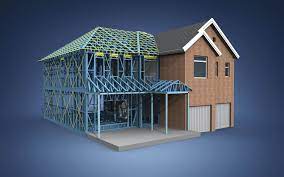3D Modeling Services in Construction: How the Industry is Benefiting
In the ever-evolving world of the construction industry, technological advancements continue to shape the way projects are planned, executed, and completed. Among these advancements, 3D modeling services in construction have emerged as a transformative tool, offering architects, engineers, contractors, and stakeholders the ability to visualize and optimize construction projects like never before. This blog moves into the profound impact of 3D modeling services on the construction industry and explores how this technology is revolutionizing the way projects are conceptualized, designed, and constructed.
How 3d Modeling Services In Construction Is Beneficial For Industries?
Enhanced Visualization and Communication
Traditionally,
construction projects relied on 2D blueprints and sketches to convey design
ideas, leaving room for misunderstandings and misinterpretations. 3D modeling
services have changed the game by enabling professionals to create intricate,
realistic visualizations of projects. This enhanced visualization not only
helps architects and designers convey their concepts more effectively to
clients and stakeholders but also aids in identifying design flaws and
potential clashes early in the process. This results in better communication,
fewer change orders, and increased client satisfaction.
Improved Design Accuracy
Precision
is paramount in construction, and 3D modeling
services in construction excel
in providing accurate representations of structures, spaces, and elements. With
the ability to create detailed digital models of buildings, infrastructure, and
landscapes, professionals can analyze every aspect of a project, from
structural integrity to spatial arrangements. This level of accuracy reduces
the chances of errors, eliminates rework, and contributes to a more streamlined
construction process. Moreover, designers can experiment with various design
iterations in the virtual realm, allowing them to fine-tune their concepts
before construction begins.
Clash Detection and Risk Mitigation
One
of the most significant advantages of 3D modeling in construction is its
capability to perform clash detection. In a complex project with numerous
systems, such as electrical, plumbing, and HVAC, clashes can arise where these
systems intersect. 3D modeling software can identify these clashes early in the
design phase, allowing engineers and contractors to resolve conflicts before
they manifest on the construction site. This preemptive approach minimizes
delays, costly rework, and potential safety hazards, ultimately reducing
project risks.
Cost and Time Savings
Implementing
3D modeling
services in construction can lead to substantial cost and time savings
throughout the construction lifecycle. By identifying clashes and design issues
in advance, project delays are minimized, and the need for on-site
modifications is reduced. Additionally, the ability to accurately estimate
materials and resources from the 3D model enhances cost forecasting. Clients
and investors benefit from a more transparent understanding of the project
scope, leading to better financial planning. The efficiency gains translate to
quicker project completion, allowing construction firms to take on more
projects and increase their overall revenue.
Stakeholder Engagement and Collaboration
Effective
collaboration among project stakeholders is pivotal for successful construction
projects. 3D modeling services facilitate seamless collaboration by providing a
common platform for architects, engineers, contractors, and clients to share
ideas, insights, and feedback. Virtual walkthroughs of 3D models enable
stakeholders to immerse themselves in the project, making it easier to make
informed decisions and address concerns. This heightened engagement leads to a
stronger sense of ownership, a more collaborative atmosphere, and ultimately,
projects that better align with the needs and expectations of all parties
involved.
Final Words
The construction industry's adoption of 3D modeling services in construction marks a significant turning point in how projects are conceptualized, designed, and executed. With enhanced visualization, improved accuracy, clash detection, cost savings, and better collaboration, 3D modeling has proven its worth as a transformative technology. As the industry continues to embrace this innovation, it is poised to benefit from reduced risks, enhanced project outcomes, and a more efficient construction process overall. With 3D modeling leading the way, the future of construction looks brighter and more promising




Comments
Post a Comment